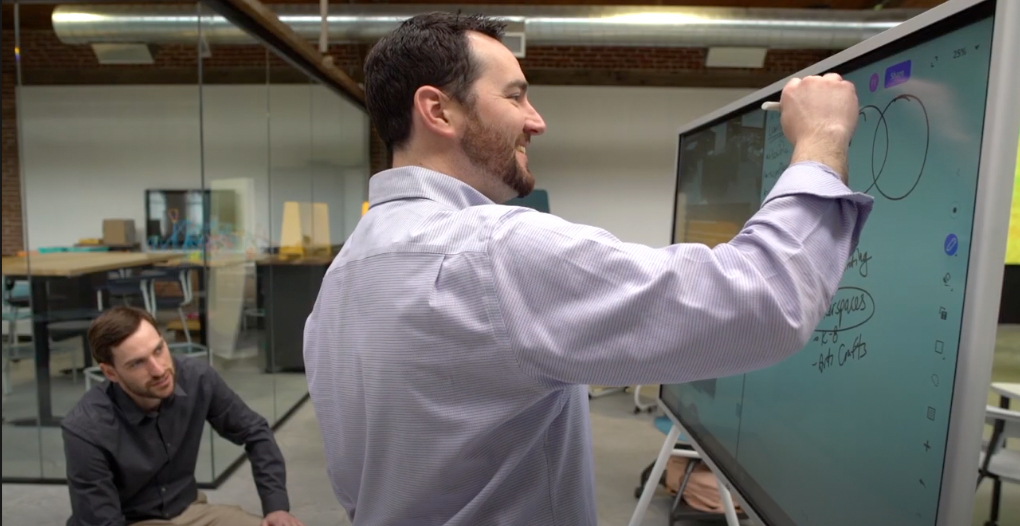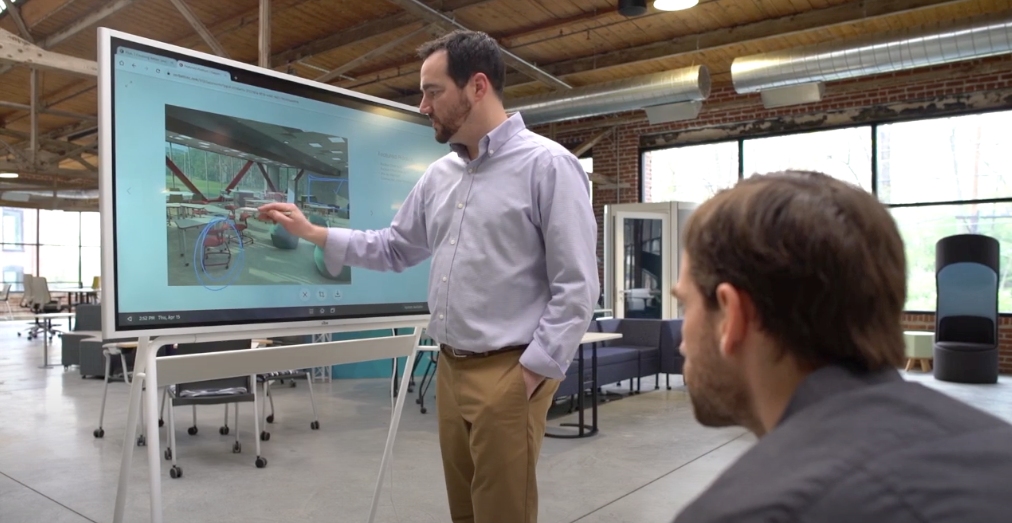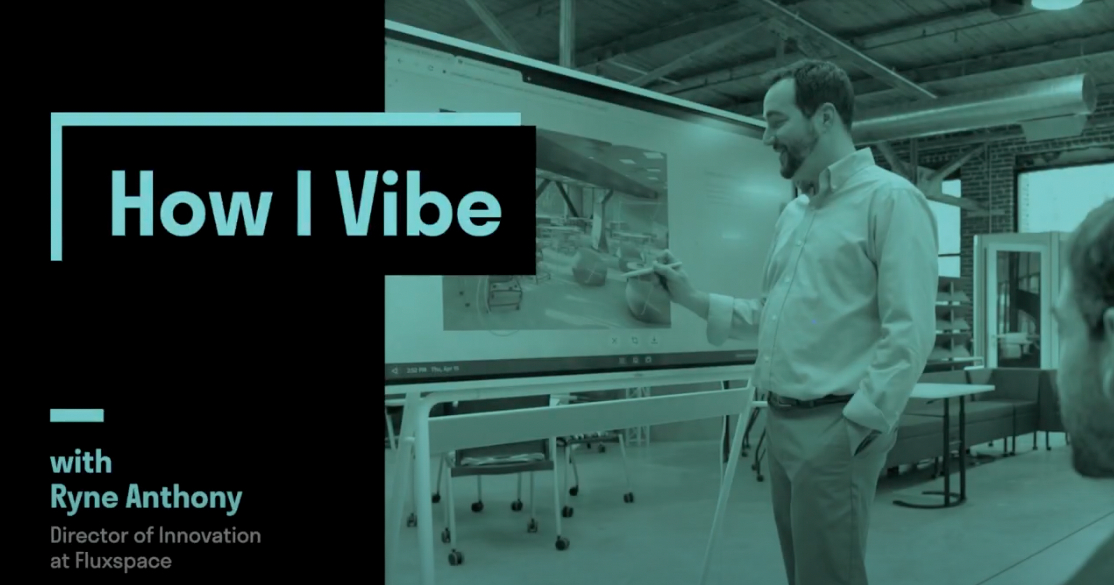Educators understand the importance of designing lesson plans. They need to be current, appropriately challenging, and creative in a way that keeps students interested in learning more. So wouldn’t it make sense for classrooms, school libraries, and other resource centers to evolve in the same way?
That’s where Fluxspace enters the picture. Located outside of Philadelphia, Fluxspace is an active experience center that serves as part showroom, part classroom, part STEM lab, and all creative, innovative design space. In short, it’s where organizations can dream up their ideal learning environment.
Ryne Anthony, Fluxspace’s director of innovation, helps organizations plan spaces that encourage a maker mindset and forward-thinking, experiential learning. Continue reading to see why Anthony says the Vibe Board plays a crucial role in the future of collaborative spaces.
How Fluxspace works
There’s so much more to creating the ultimate learning space than simply choosing comfortable furniture. Anthony explains that at Fluxspace, they take the future of the space into consideration as well. They ask themselves, “What does the classroom of the future look like? How can we build really cool, really engaging environments? And what are the products, programs, and experiences that should take place in them?”
In addition to hosting school workshops and STEM camps, Fluxspace is also used for consultations and product demos. There’s always an opportunity to see how designs at Fluxspace could translate into actual spaces on a school campus. And with schools and office buildings reopening after a year of uncertainty, Anthony’s schedule is filling up with demo requests.
“We’re gearing up to do a lot more,” Anthony said. “It’s cool; a lot of schools are reaching out saying, ‘Hey, we’re finally getting back to redoing this library’ and ‘We’re finally getting back to this or that.’ The goal is [to] get them here, we get them excited and help them dream up what their space could look like. Not just from furniture but all the products, programs, and what experience should happen in the space. It’s been good.”
The challenge: creating classrooms with collaboration in mind
Today’s classrooms are almost completely different from the traditional images many of us grew up with. Clunky desks and dusty chalkboards have all but disappeared. Thick, heavy textbooks are being replaced with online editions students can read on school-issued laptops. Even dry erase boards, once considered the hallmark of a “modern” classroom, are showing up less and less.
One of the key features in a dynamic learning space is flexibility in design. Ideally, everything in the room should be mobile and easily reconfigured to accommodate the day’s activities. However, technology has proven to be a tricky component.
“One of the problems we’re running into all the time with our clients is trying to help them bring in video collaboration or even just some kind of technology that can help with collaboration, but [we want] something that’s mobile, something that can move around,” Anthony explained. “So when we found Vibe…we realized, ‘Hey, this could be a really great product for our clients and even for us to use internally.’”
Related: How the Right Work Space Can Spark Creativity
How Fluxspace chose Vibe
“The big thing right now is there’s no front of the classroom,” Anthony said. “Classrooms are more dynamic, more collaborative, more station-based, and you need technology that can easily roll around and move and promote that type of learning.”
The ability to set the Vibe Board on a portable stand and use it anywhere was a game changer.
“When we found Vibe, it was [the] solution for us. It was mobile, easy to move around, easy to plug in different ways,” Anthony said. “It provided this solution to us and our clients in terms of [being able to say], ‘Here’s a piece of technology that you can wheel around that still allows you to have a mobile, reconfigured space that can be used in different ways.’ The functionality and ability of the Vibe Board was huge for us and has been great.”

Using Vibe in the classroom
Working at Fluxspace gives Anthony plenty of opportunities to reimagine the classroom experience from an innovator’s perspective. But he’s also able to design room layouts from a teacher’s point of view. A former educator himself, Anthony constantly thinks of ways that a Vibe Board can be used in class.
“I think it’s a really great tool for students to hop up and use and for them to brainstorm ideas,” he said. “A lot of times, schools are moving toward station rotations or small group work, and the ability to send a small group of students to an area and have them brainstorm and write ideas on a board is huge. So having [the Vibe Board] be a resource and tool to allow them to do a better job at collaboration is awesome.”
He also sees Vibe as an excellent instructional tool for educators to utilize. Anthony believes the functionality of both Vibe’s hardware and collaboration software creates an exciting learning environment. And not just for students—for teachers, too.
“Having the ability to move [the board] around as a teacher to different stations, or to have that set up—one day it could be in the front of the room, the other day it can be by a back table; again, having that functionality [of movement] is really great for teachers. So as an educator, I’m most excited about having [Vibe] be used around the whole learning environment.”
How the Fluxspace team uses Vibe
Client presentations at Fluxspace often include the Vibe Board. Anthony elaborated, “We’re leveraging it as a better sales tool and a better tool for us to pitch our services and ideas.”
For instance, they can easily pull up digital files of design renderings or products on Vibe’s 55” 4K screen. This helps their clients visualize what certain spaces or experiences could look like. They also rely on Vibe’s digital annotation tools to make changes in real time.
“Being able to annotate over [images], circle things that they like, cross off things that they didn’t—and not just doing that on a piece of paper we printed out. We’re able to do that on the big board,” Anthony said. “Then we send those [files] out to the client, or our designers and reps, and we’re able to understand the exact needs of the client.” The annotation combined with Vibe’s simultaneous app usage ability takes the guesswork out of this kind of ever-evolving collaboration.
But the Vibe Board’s usefulness isn’t limited to displaying designs; it plays an integral part in making these imagined spaces a reality. Anthony tells clients they could have this “go-to piece of technology” in their own organization for a truly collaborative experience.
Anthony said, “We always talk about how it’s not just the furniture, it’s not just the technology, it’s not just the culture—it’s all those things together [that] makes a room a really great, well-rounded learning environment.”

The team’s favorite Vibe features
Similar to many other Vibe fans, one of Anthony’s favorite features is the board’s extremely flexible app integration.
“You’re not locked into just one software or just one platform; it’s platform- and device-agnostic, if you will,” he said. “That’s huge for schools and learning organizations because they might have one platform for email and [another] platform for their learning management system, and it might be a whole mix of things. And to have a board be able to work and be compatible with all those programs and platforms is huge.”
The Fluxspace team also likes the split screen feature, particularly for presentations. That’s because “you can have a presentation on one side and do a demo on the other. The ability to hook up a camera on the USB ports is awesome, and again, having that be useful in more ways than one, not just being a whiteboard.” If they need to switch from presenting to a Zoom call and back, or over to Google Meet, they have the freedom to do that.
One of the more pleasant surprises about Vibe? That this kind of functionality comes at a competitive price. As Anthony explains it, “You know, a lot of products out there are almost too robust or almost overkill in terms of the features they have, and that comes with a higher price tag. So for us to be able to have these features we need at a more cost effective option has been great.”
Related: Best Practices for Remote Student Engagement at All Levels
Final thoughts
While Anthony is excited to have more schools and organizations visiting the Fluxspace experience center, the past year has taught him (and many of us) a lot. He more deeply understands that technology needs to be leveraged to meet everyone where they’re at. And in some cases, that applies to people who are still working and learning from home.
“Not all students are going back to the classrooms in the fall, and there might be some students that are learning from home,” he said. “To have that ability to teach both in the classroom and students at home at the same time is a great solution… It’s the idea that [technology] needs to serve a purpose and needs to allow people to do something they might not have been able to without using that technology. And that’s the best form of integration when we’re working with our clients.”
He sees the same need with corporate clients who need to make the transition to working within hybrid teams easier. Anthony said, “They’re going to be looking for that ability to move around and be in different areas in the building, and in terms of [Vibe] being a collaborative tool that ideas can be shared on and, at the same time, really easily be shared back home or with people who are still working remotely, that’s a very important feature too.”
When Anthony recommends Vibe to his clients, it really all boils down to this: “The ability [for the Vibe Board] to be at the cost that it’s at with the features it provides, and for it to be a mobile, functional tool that can move around is huge. And it’s going to help a lot of organizations.”
Vibe offers a collaborative solution combining an interactive digital whiteboard and innovative smart software. Increase engagement and efficiency at your brainstorming sessions, virtual training, and classroom sessions by integrating your favorite applications with video conferencing and an infinite, mess-free writing canvas. Collaborate today with Vibe.
Looking for the latest in interactive whiteboard technology? Check out Vibe today!
